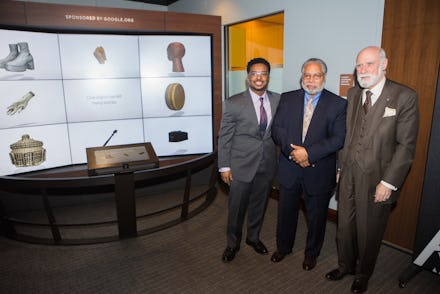Google’s 3-D installation offers a glimpse at the future of black history artifacts

The National Museum of African American History and Culture houses 3,000 relics on its showroom floor. Each artifact has shaped black history in its own way. But the museum’s total stockpile is much greater: nearly 40,000 items.
The museum, affectionately referred to as the “Blacksonian,” wanted to find a way to make those other 37,000 pieces of history available for viewing to the public. So it asked Google to help the museum digitize its collection. To start, Google and the “Blacksonian” have scanned some of the museum’s favorite items that were previously locked in storage and rendered them to be included in Google’s 3-D artifact installation.
“The museum asked us to help them bring the stories surrounding these artifacts to life in a way that wasn’t possible in the physical museum.” Dr. Travis McPhail, a black Google Maps engineer who was tasked with leading the team involved with the digitization project. “The artifacts that are debuting at this exhibit wouldn’t have been in the museum otherwise.”
The digital artifact exhibit will display 10 items: athlete and activist Seba Johnson’s ski boots, a sculpture by artist Elizabeth Catlett, a carved bust of former president of Ghana Kwame Nkrumah, a tin of entrepreneur Madam C.J. Walker’s Wonderful Hair Grower, a mold of pianist Eubie Blake’s left hand, costume boots from The Wiz, an egg carton from Muslim farms (a company owned by the Nation of Islam), a sweetgrass basket from South Carolina, a vanilla bean wrap hat and a patent model for the refrigerator by Thomas Elkins.
When exploring an object, the 3-D experience will overlay related imagery and facts that give context to the item’s past and even prompt you to answer questions about the artifact.
In addition to scanning these items for their own exhibit, Google has gifted faster 3-D scanners to the museum. Scans that would have previously taken anywhere between hours and weeks now take around five minutes, McPhail said.
There are several reasons why some artifacts are easier to display on a museum’s showroom floor: Some are too delicate to be transported while others can’t withstand the harsh lighting. Digitizing them, on the other hand, introduces another set of challenges.
“The tech only worked with objects of a certain dimension or of a specific material,” Katy Kendrick, the museum’s curator for the 3-D artifact installation, said. “Reflective objects like shiny metal didn’t read as well, whereas Elizabeth Catlett’s terra-cotta sculpture turned out perfectly.”
Google’s artifact scanner may not play nice with certain materials, but the resulting images will be supported by more than just Google-branded machines. The team used standard file formats for the scanned artifacts, so the images are available for anyone to use. Or could be, that is. “The barrier to entry, if the museum chooses to make these things public, is low,” McPhail said.
The museum hasn’t expressed plans to make their collection available in this way, but there’s a chance they may be open to more virtual means of exploring their collection.
“Digitization is a huge part of the museums strategy when it comes to sharing our museum’s collection,” Kendrick said. “We’re a Smithsonian institution, so not only are we a part of a growing database of millions of artifacts, but it’s all free. Sharing our collection with the public is our mandate and our mission.”